ECU TOYOTA YARIS HYBRID 2013 Owner's Manual
[x] Cancel search | Manufacturer: TOYOTA, Model Year: 2013, Model line: YARIS HYBRID, Model: TOYOTA YARIS HYBRID 2013Pages: 700, PDF Size: 28.68 MB
Page 200 of 700
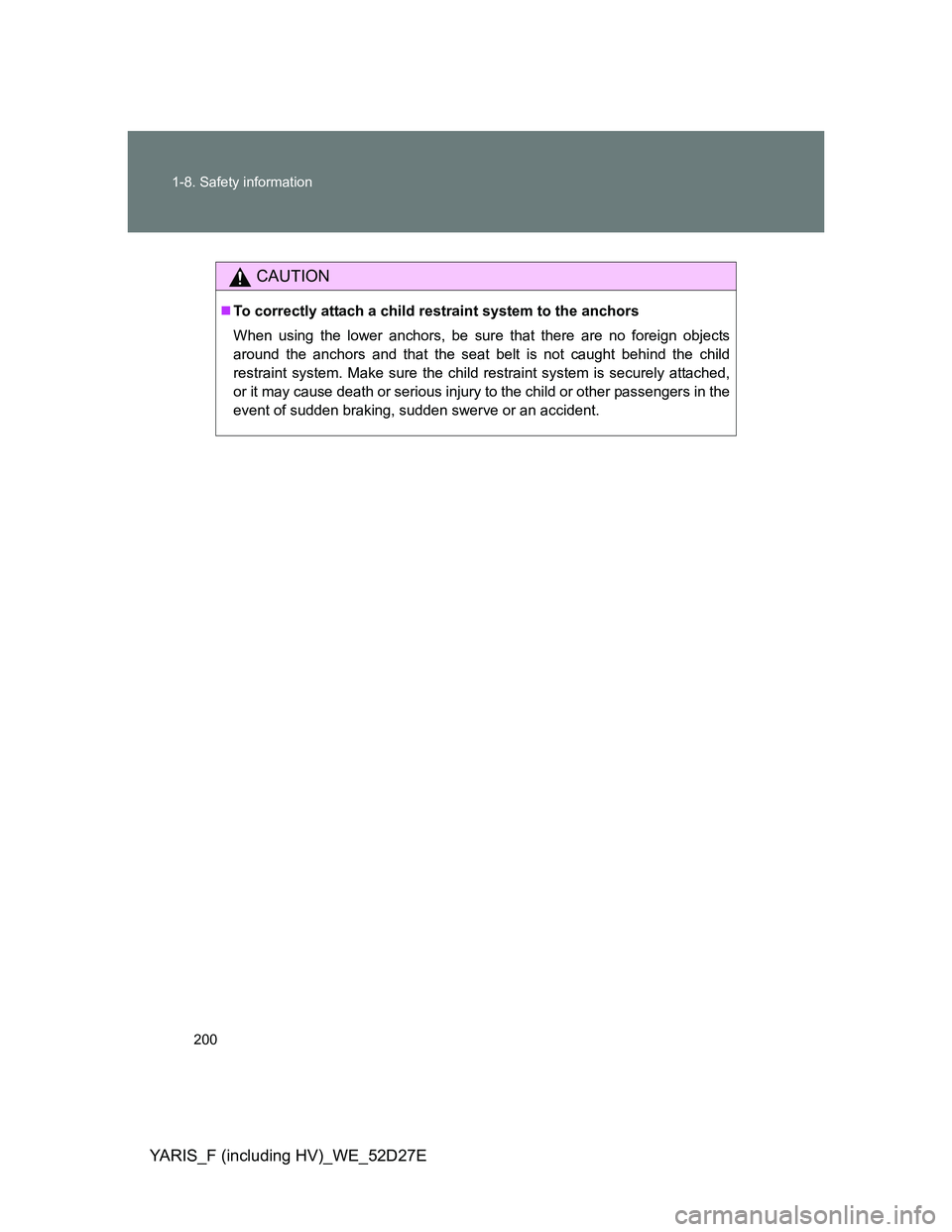
200 1-8. Safety information
YARIS_F (including HV)_WE_52D27E
CAUTION
To correctly attach a child restraint system to the anchors
When using the lower anchors, be sure that there are no foreign objects
around the anchors and that the seat belt is not caught behind the child
restraint system. Make sure the child restraint system is securely attached,
or it may cause death or serious injury to the child or other passengers in the
event of sudden braking, sudden swerve or an accident.
Page 214 of 700
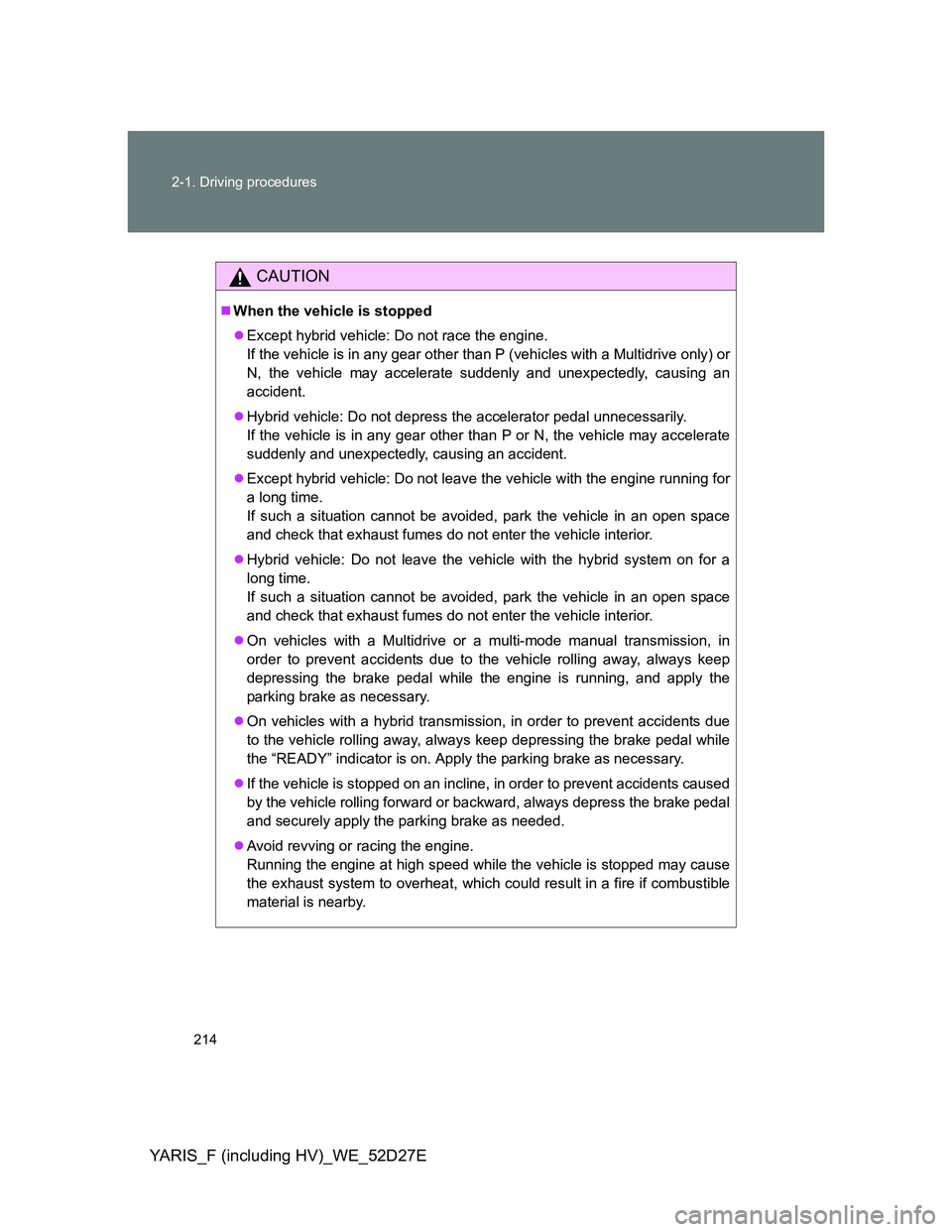
214 2-1. Driving procedures
YARIS_F (including HV)_WE_52D27E
CAUTION
When the vehicle is stopped
Except hybrid vehicle: Do not race the engine.
If the vehicle is in any gear other than P (vehicles with a Multidrive only) or
N, the vehicle may accelerate suddenly and unexpectedly, causing an
accident.
Hybrid vehicle: Do not depress the accelerator pedal unnecessarily.
If the vehicle is in any gear other than P or N, the vehicle may accelerate
suddenly and unexpectedly, causing an accident.
Except hybrid vehicle: Do not leave the vehicle with the engine running for
a long time.
If such a situation cannot be avoided, park the vehicle in an open space
and check that exhaust fumes do not enter the vehicle interior.
Hybrid vehicle: Do not leave the vehicle with the hybrid system on for a
long time.
If such a situation cannot be avoided, park the vehicle in an open space
and check that exhaust fumes do not enter the vehicle interior.
On vehicles with a Multidrive or a multi-mode manual transmission, in
order to prevent accidents due to the vehicle rolling away, always keep
depressing the brake pedal while the engine is running, and apply the
parking brake as necessary.
On vehicles with a hybrid transmission, in order to prevent accidents due
to the vehicle rolling away, always keep depressing the brake pedal while
the “READY” indicator is on. Apply the parking brake as necessary.
If the vehicle is stopped on an incline, in order to prevent accidents caused
by the vehicle rolling forward or backward, always depress the brake pedal
and securely apply the parking brake as needed.
Avoid revving or racing the engine.
Running the engine at high speed while the vehicle is stopped may cause
the exhaust system to overheat, which could result in a fire if combustible
material is nearby.
Page 218 of 700
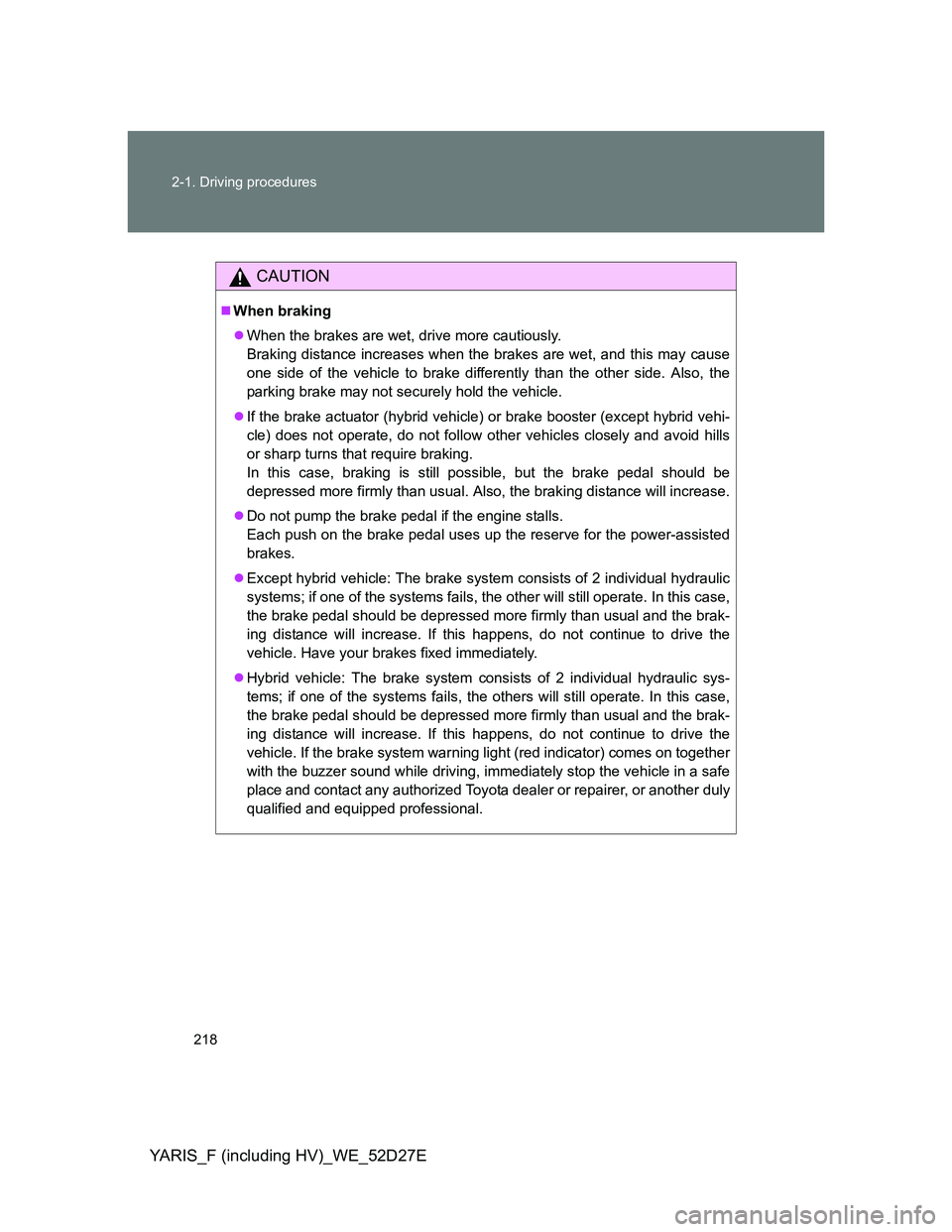
218 2-1. Driving procedures
YARIS_F (including HV)_WE_52D27E
CAUTION
When braking
When the brakes are wet, drive more cautiously.
Braking distance increases when the brakes are wet, and this may cause
one side of the vehicle to brake differently than the other side. Also, the
parking brake may not securely hold the vehicle.
If the brake actuator (hybrid vehicle) or brake booster (except hybrid vehi-
cle) does not operate, do not follow other vehicles closely and avoid hills
or sharp turns that require braking.
In this case, braking is still possible, but the brake pedal should be
depressed more firmly than usual. Also, the braking distance will increase.
Do not pump the brake pedal if the engine stalls.
Each push on the brake pedal uses up the reserve for the power-assisted
brakes.
Except hybrid vehicle: The brake system consists of 2 individual hydraulic
systems; if one of the systems fails, the other will still operate. In this case,
the brake pedal should be depressed more firmly than usual and the brak-
ing distance will increase. If this happens, do not continue to drive the
vehicle. Have your brakes fixed immediately.
Hybrid vehicle: The brake system consists of 2 individual hydraulic sys-
tems; if one of the systems fails, the others will still operate. In this case,
the brake pedal should be depressed more firmly than usual and the brak-
ing distance will increase. If this happens, do not continue to drive the
vehicle. If the brake system warning light (red indicator) comes on together
with the buzzer sound while driving, immediately stop the vehicle in a safe
place and contact any authorized Toyota dealer or repairer, or another duly
qualified and equipped professional.
Page 232 of 700
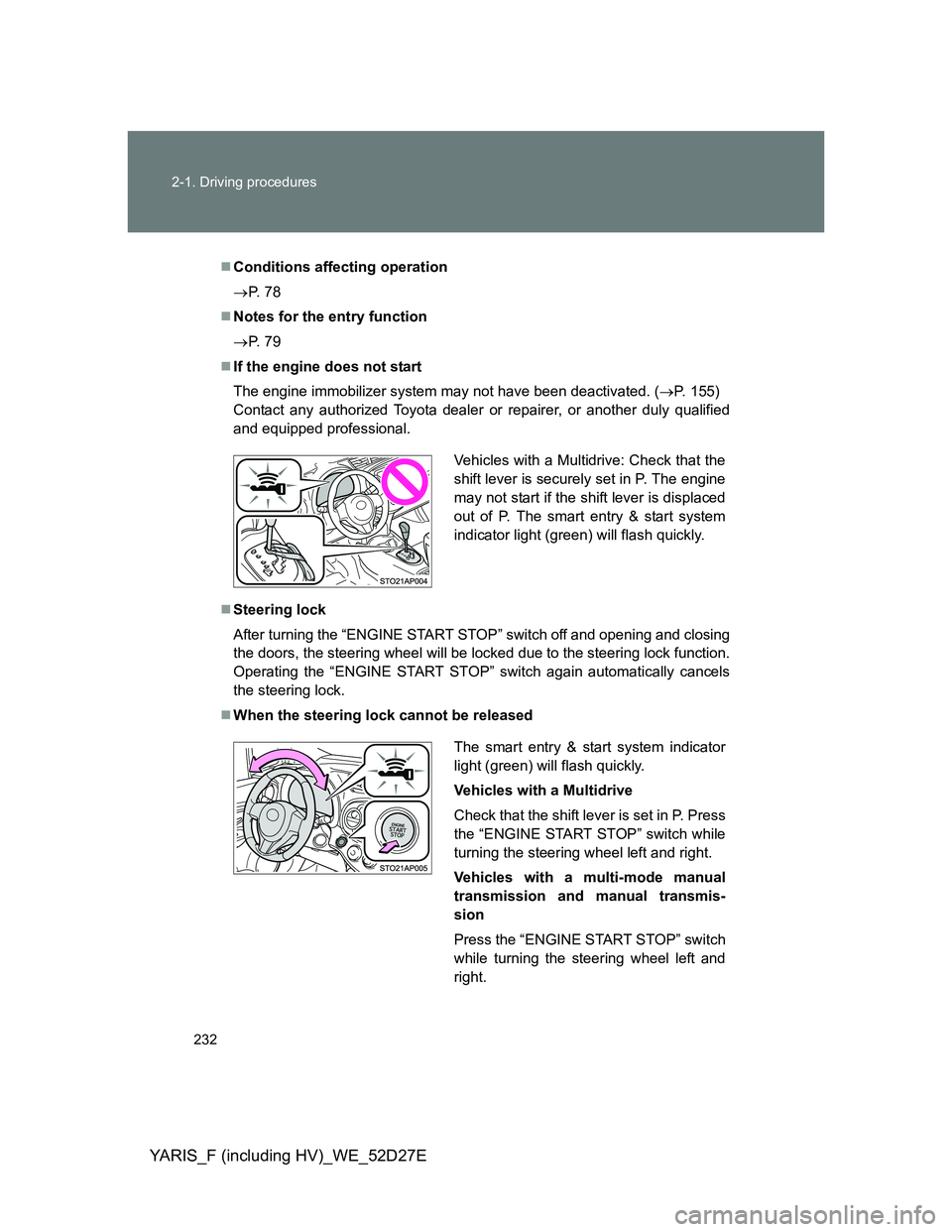
232 2-1. Driving procedures
YARIS_F (including HV)_WE_52D27E
Conditions affecting operation
P. 7 8
Notes for the entry function
P. 7 9
If the engine does not start
The engine immobilizer system may not have been deactivated. (P. 155)
Contact any authorized Toyota dealer or repairer, or another duly qualified
and equipped professional.
Steering lock
After turning the “ENGINE START STOP” switch off and opening and closing
the doors, the steering wheel will be locked due to the steering lock function.
Operating the “ENGINE START STOP” switch again automatically cancels
the steering lock.
When the steering lock cannot be released
Vehicles with a Multidrive: Check that the
shift lever is securely set in P. The engine
may not start if the shift lever is displaced
out of P. The smart entry & start system
indicator light (green) will flash quickly.
The smart entry & start system indicator
light (green) will flash quickly.
Vehicles with a Multidrive
Check that the shift lever is set in P. Press
the “ENGINE START STOP” switch while
turning the steering wheel left and right.
Vehicles with a multi-mode manual
transmission and manual transmis-
sion
Press the “ENGINE START STOP” switch
while turning the steering wheel left and
right.
Page 245 of 700
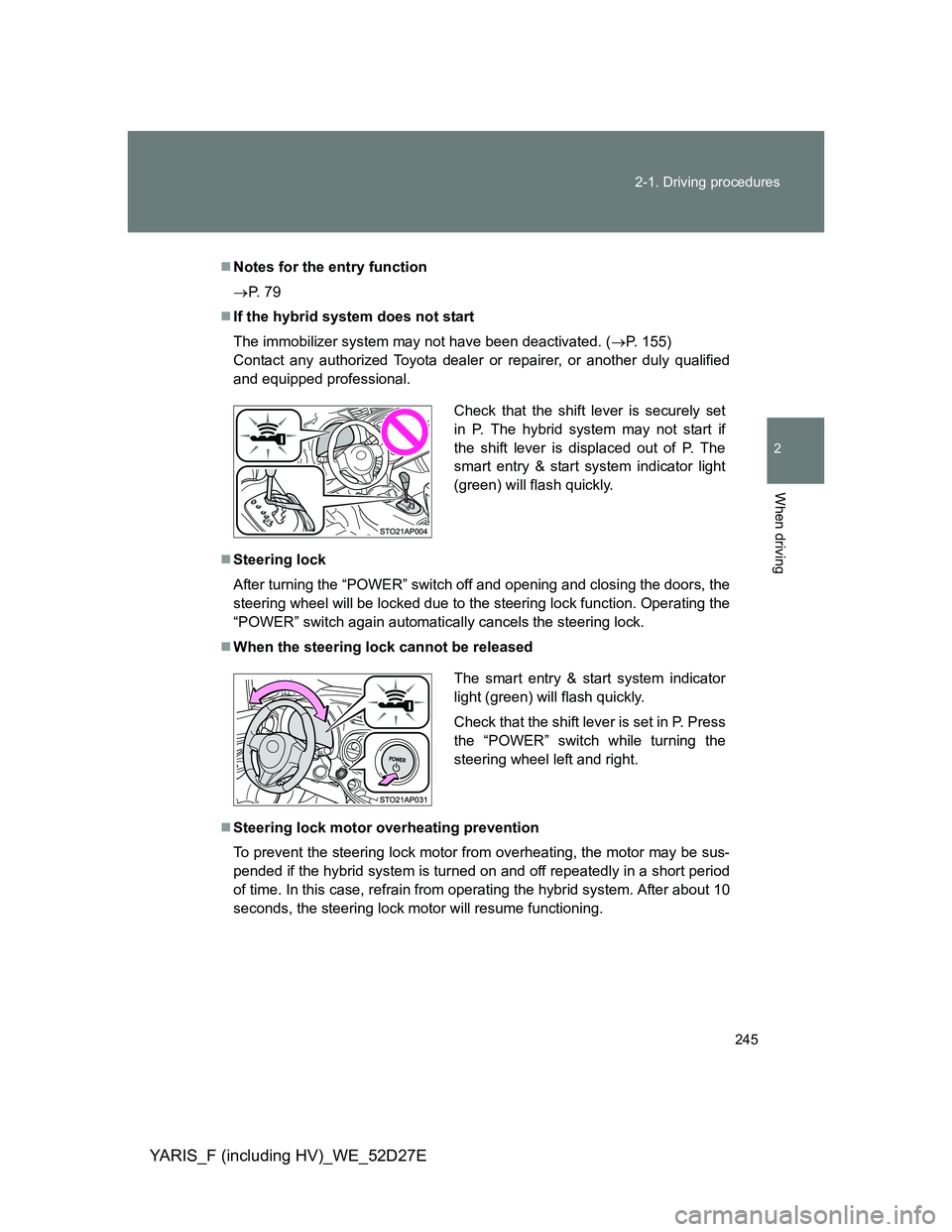
245 2-1. Driving procedures
2
When driving
YARIS_F (including HV)_WE_52D27E
Notes for the entry function
P. 7 9
If the hybrid system does not start
The immobilizer system may not have been deactivated. (P. 155)
Contact any authorized Toyota dealer or repairer, or another duly qualified
and equipped professional.
Steering lock
After turning the “POWER” switch off and opening and closing the doors, the
steering wheel will be locked due to the steering lock function. Operating the
“POWER” switch again automatically cancels the steering lock.
When the steering lock cannot be released
Steering lock motor overheating prevention
To prevent the steering lock motor from overheating, the motor may be sus-
pended if the hybrid system is turned on and off repeatedly in a short period
of time. In this case, refrain from operating the hybrid system. After about 10
seconds, the steering lock motor will resume functioning.
Check that the shift lever is securely set
in P. The hybrid system may not start if
the shift lever is displaced out of P. The
smart entry & start system indicator light
(green) will flash quickly.
The smart entry & start system indicator
light (green) will flash quickly.
Check that the shift lever is set in P. Press
the “POWER” switch while turning the
steering wheel left and right.
Page 270 of 700
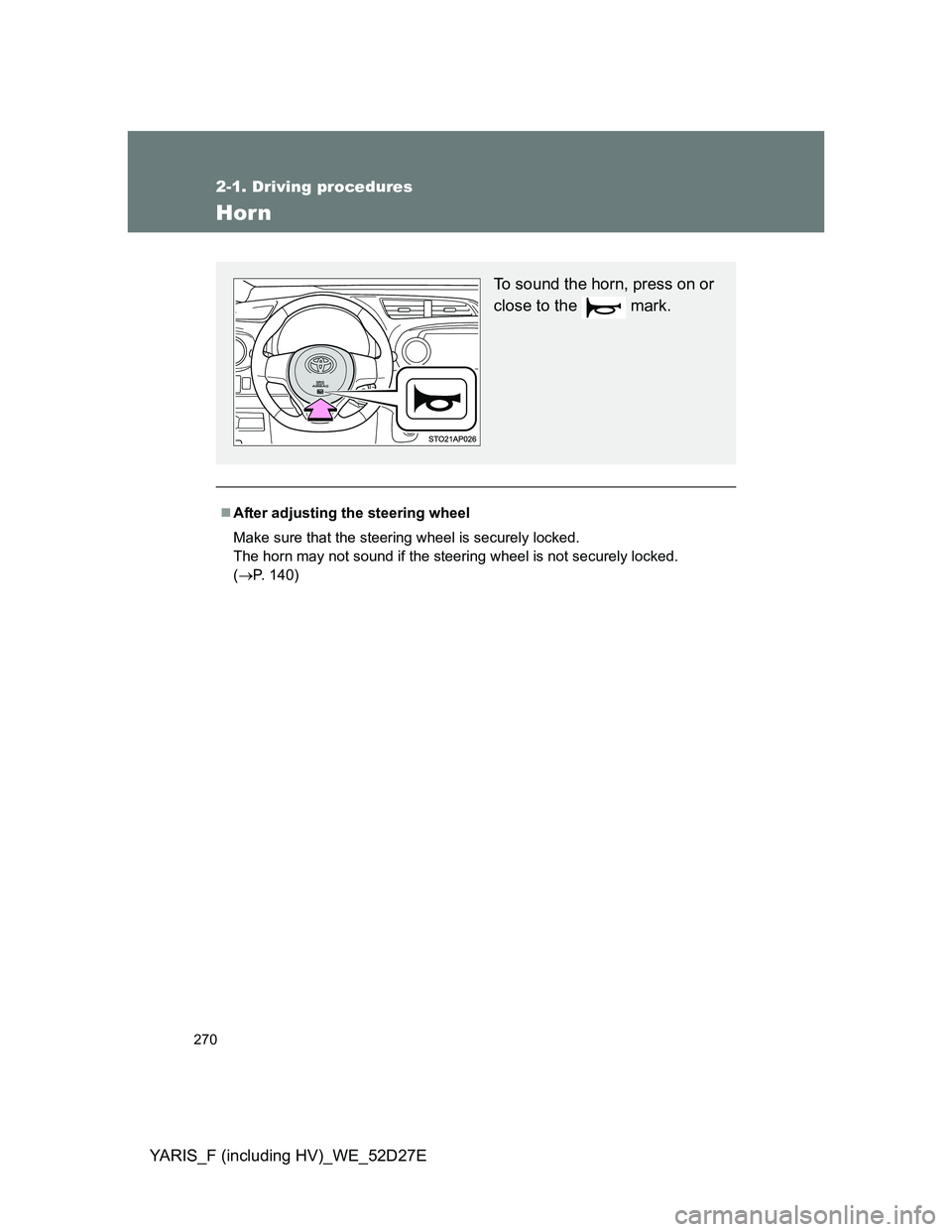
270
2-1. Driving procedures
YARIS_F (including HV)_WE_52D27E
Horn
After adjusting the steering wheel
Make sure that the steering wheel is securely locked.
The horn may not sound if the steering wheel is not securely locked.
(P. 140)
To sound the horn, press on or
close to the mark.
Page 300 of 700
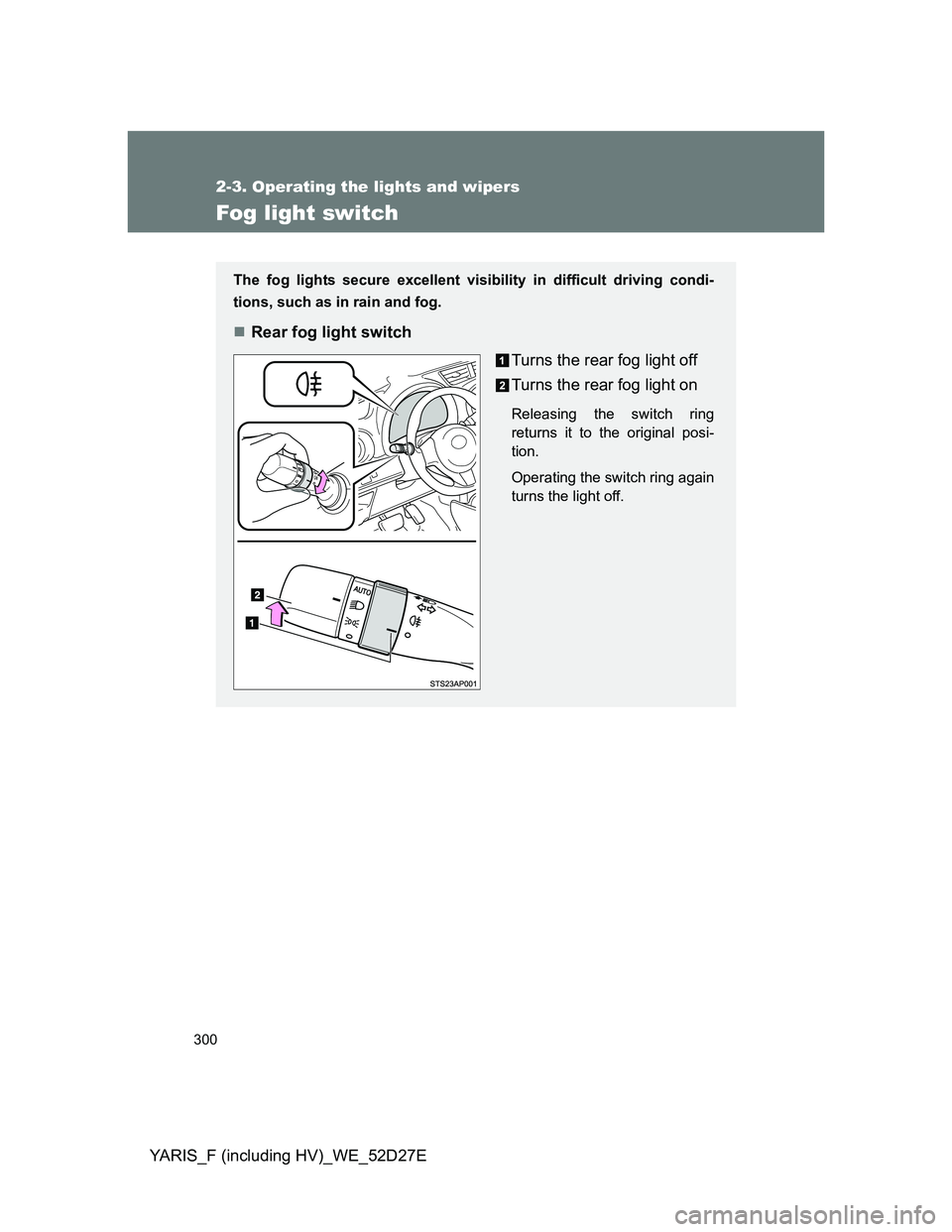
300
2-3. Operating the lights and wipers
YARIS_F (including HV)_WE_52D27E
Fog light switch
The fog lights secure excellent visibility in difficult driving condi-
tions, such as in rain and fog.
Rear fog light switch
Turns the rear fog light off
Turns the rear fog light on
Releasing the switch ring
returns it to the original posi-
tion.
Operating the switch ring again
turns the light off.
Page 334 of 700
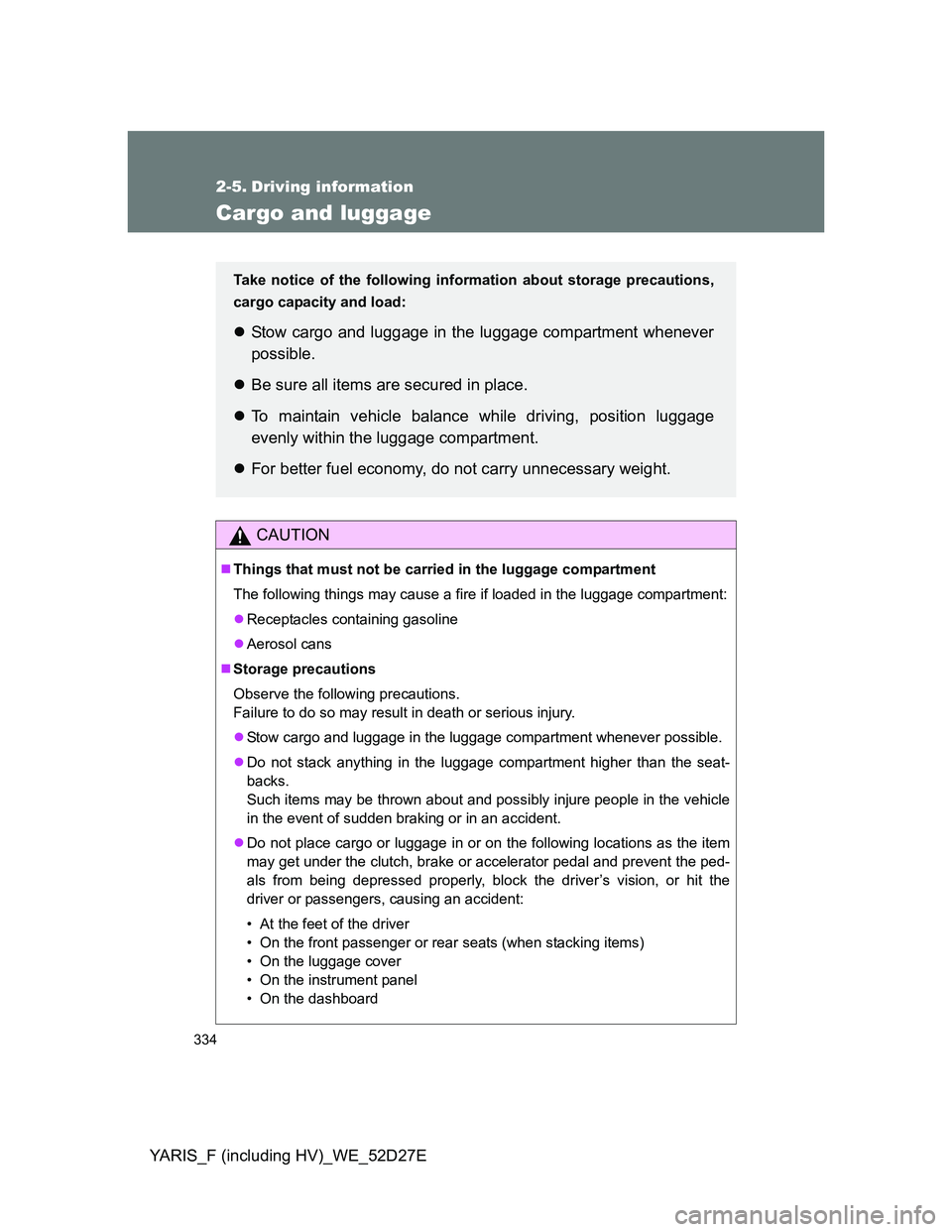
334
YARIS_F (including HV)_WE_52D27E
2-5. Driving information
Cargo and luggage
CAUTION
Things that must not be carried in the luggage compartment
The following things may cause a fire if loaded in the luggage compartment:
Receptacles containing gasoline
Aerosol cans
Storage precautions
Observe the following precautions.
Failure to do so may result in death or serious injury.
Stow cargo and luggage in the luggage compartment whenever possible.
Do not stack anything in the luggage compartment higher than the seat-
backs.
Such items may be thrown about and possibly injure people in the vehicle
in the event of sudden braking or in an accident.
Do not place cargo or luggage in or on the following locations as the item
may get under the clutch, brake or accelerator pedal and prevent the ped-
als from being depressed properly, block the driver’s vision, or hit the
driver or passengers, causing an accident:
• At the feet of the driver
• On the front passenger or rear seats (when stacking items)
• On the luggage cover
• On the instrument panel
• On the dashboard
Take notice of the following information about storage precautions,
cargo capacity and load:
Stow cargo and luggage in the luggage compartment whenever
possible.
Be sure all items are secured in place.
To maintain vehicle balance while driving, position luggage
evenly within the luggage compartment.
For better fuel economy, do not carry unnecessary weight.
Page 335 of 700
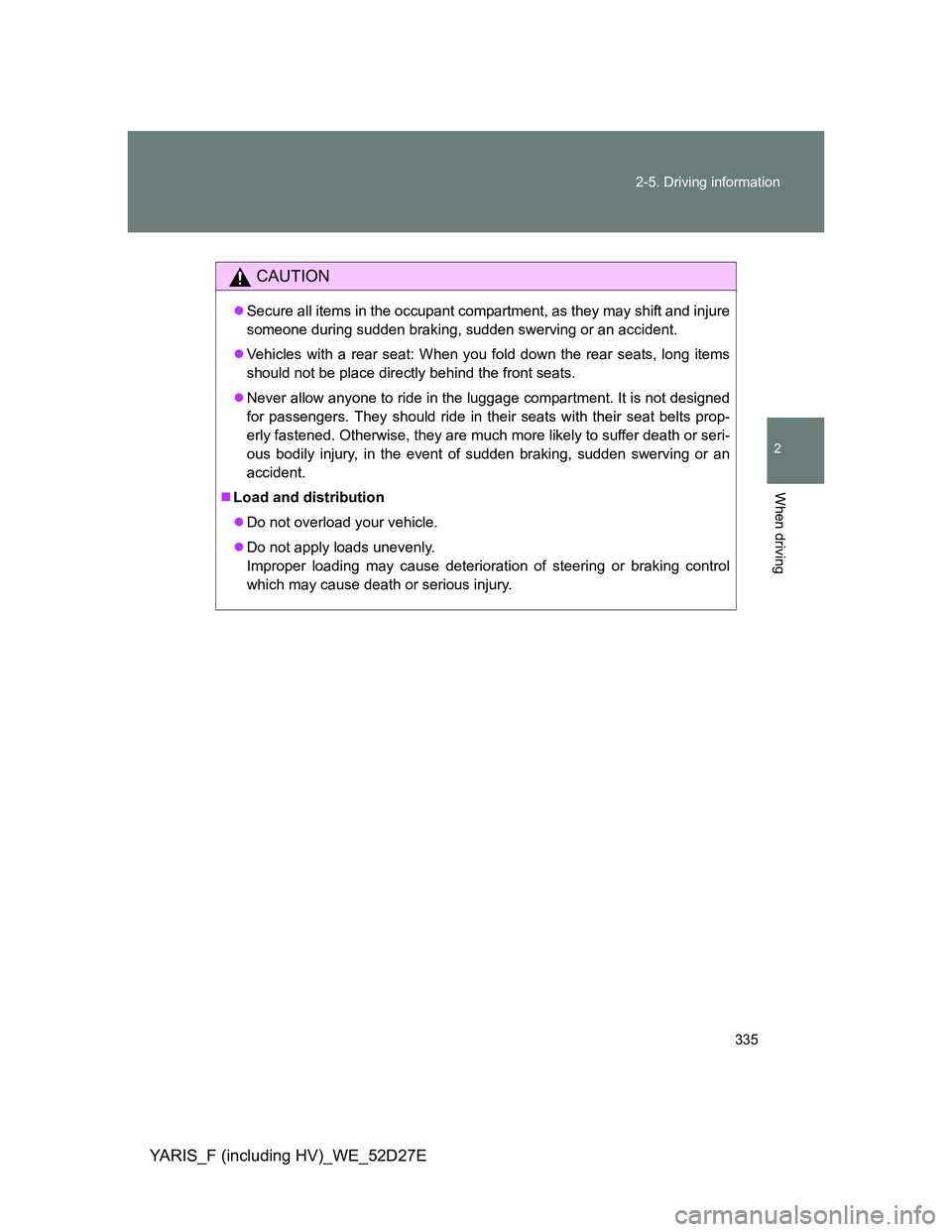
335 2-5. Driving information
2
When driving
YARIS_F (including HV)_WE_52D27E
CAUTION
Secure all items in the occupant compartment, as they may shift and injure
someone during sudden braking, sudden swerving or an accident.
Vehicles with a rear seat: When you fold down the rear seats, long items
should not be place directly behind the front seats.
Never allow anyone to ride in the luggage compartment. It is not designed
for passengers. They should ride in their seats with their seat belts prop-
erly fastened. Otherwise, they are much more likely to suffer death or seri-
ous bodily injury, in the event of sudden braking, sudden swerving or an
accident.
Load and distribution
Do not overload your vehicle.
Do not apply loads unevenly.
Improper loading may cause deterioration of steering or braking control
which may cause death or serious injury.
Page 347 of 700
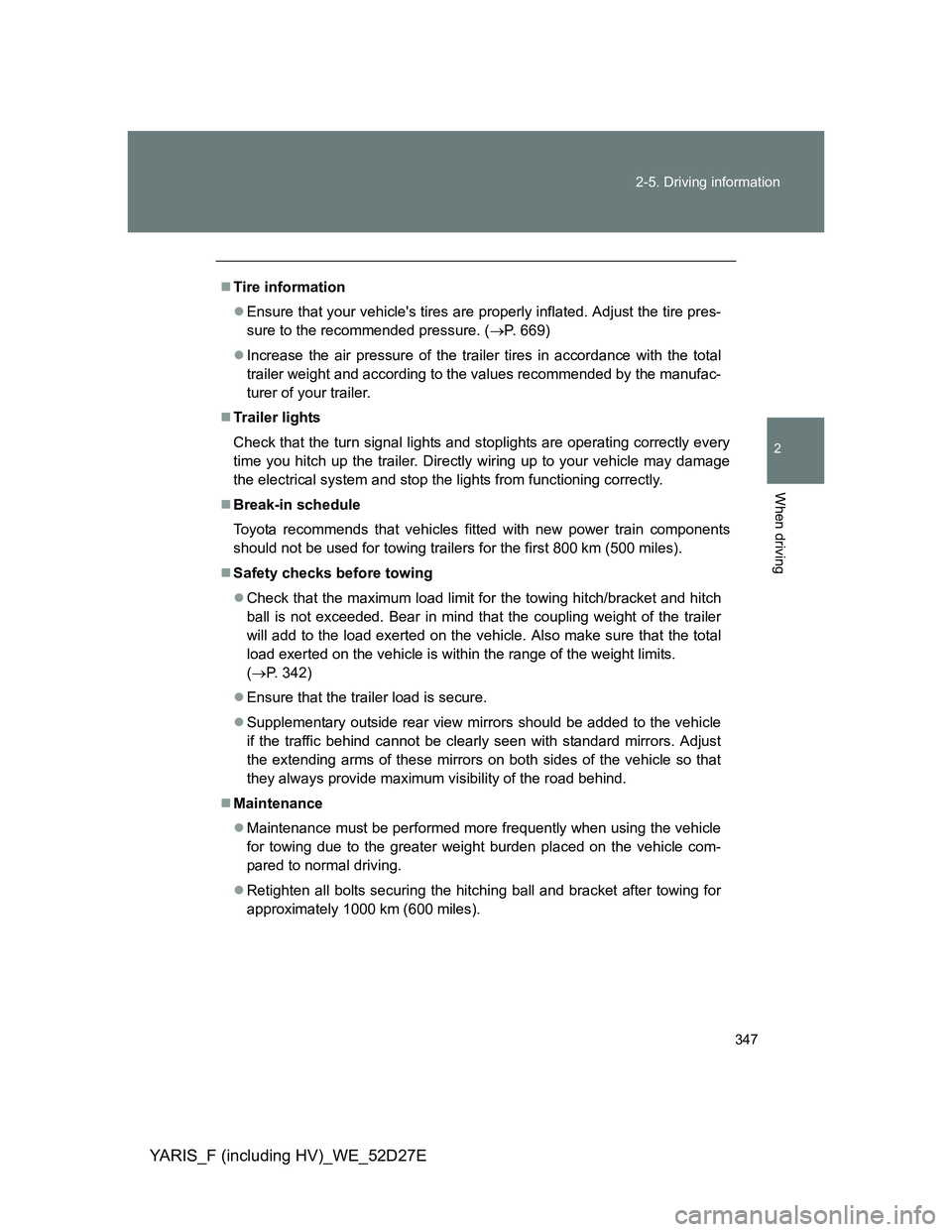
347 2-5. Driving information
2
When driving
YARIS_F (including HV)_WE_52D27E
Tire information
Ensure that your vehicle's tires are properly inflated. Adjust the tire pres-
sure to the recommended pressure. (P. 669)
Increase the air pressure of the trailer tires in accordance with the total
trailer weight and according to the values recommended by the manufac-
turer of your trailer.
Trailer lights
Check that the turn signal lights and stoplights are operating correctly every
time you hitch up the trailer. Directly wiring up to your vehicle may damage
the electrical system and stop the lights from functioning correctly.
Break-in schedule
Toyota recommends that vehicles fitted with new power train components
should not be used for towing trailers for the first 800 km (500 miles).
Safety checks before towing
Check that the maximum load limit for the towing hitch/bracket and hitch
ball is not exceeded. Bear in mind that the coupling weight of the trailer
will add to the load exerted on the vehicle. Also make sure that the total
load exerted on the vehicle is within the range of the weight limits.
(P. 342)
Ensure that the trailer load is secure.
Supplementary outside rear view mirrors should be added to the vehicle
if the traffic behind cannot be clearly seen with standard mirrors. Adjust
the extending arms of these mirrors on both sides of the vehicle so that
they always provide maximum visibility of the road behind.
Maintenance
Maintenance must be performed more frequently when using the vehicle
for towing due to the greater weight burden placed on the vehicle com-
pared to normal driving.
Retighten all bolts securing the hitching ball and bracket after towing for
approximately 1000 km (600 miles).